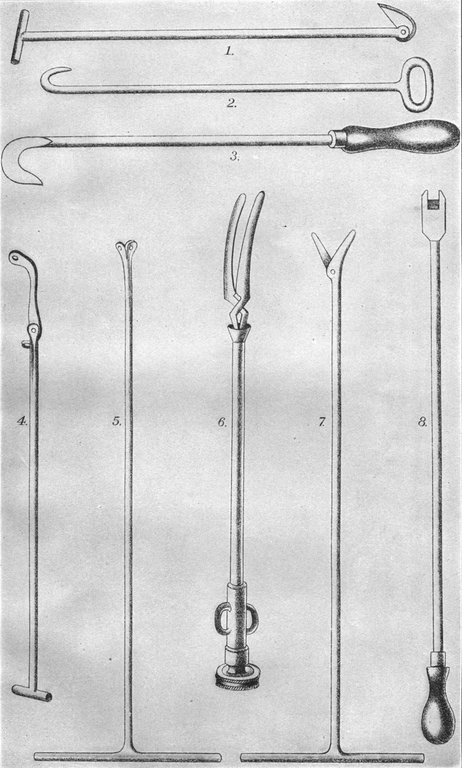
PLATE XX.
INSTRUMENTS USED IN DIFFICULT LABOR.

PLATE XX. Instruments used in difficult labor.
Fig. 1. Long embryotome with joint.
Fig. 2. Long, sharp hook. This instrument is about 3 feet in length, including the handle. Hooks of this kind, both blunt and sharp, are applied directly to the fetus to assist in delivery.
Fig. 3. GŁnther's long-handled embryotome. This instrument and that represented in Fig. 1 are of special value in cutting through muscular tissue and in separating the limbs from the trunk when the fetus can not be removed entire. These embryotomes are usually 30 inches long, but may be made either longer or shorter.
Fig. 4. Jointed cord-carrier, used in difficult parturition to carry a cord into regions which can not be reached by the arm.
Fig. 5. Instrument used to rotate or turn the fetus, known as a rotator.
Fig. 6. Dilator of the neck of the womb, used when conception can not take place owing to a contracted condition of the neck of the womb.
Fig. 7. Repeller. An instrument from 2 to 3 feet long, used to force the fetus forward into the womb. This operation is generally necessary when the presentation is abnormal and the fetus has advanced too far into the narrow inlet to the uterus to be moved.
Fig. 8. Cartwright's bone chisel. Including the handle, this instrument is about 32 inches in length; the chisel portion is a little more than 2 inches long and 1 to 1-1/2 broad. Only the middle portion is sharp, the projecting corners are blunt, and the sides rounded. This instrument is used for slitting up the skin of a limb and as a bone chisel when it is necessary to mutilate the fetus in order to effect delivery.